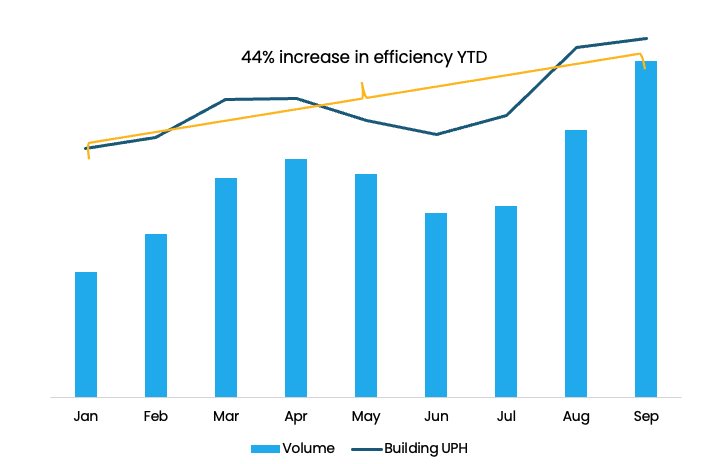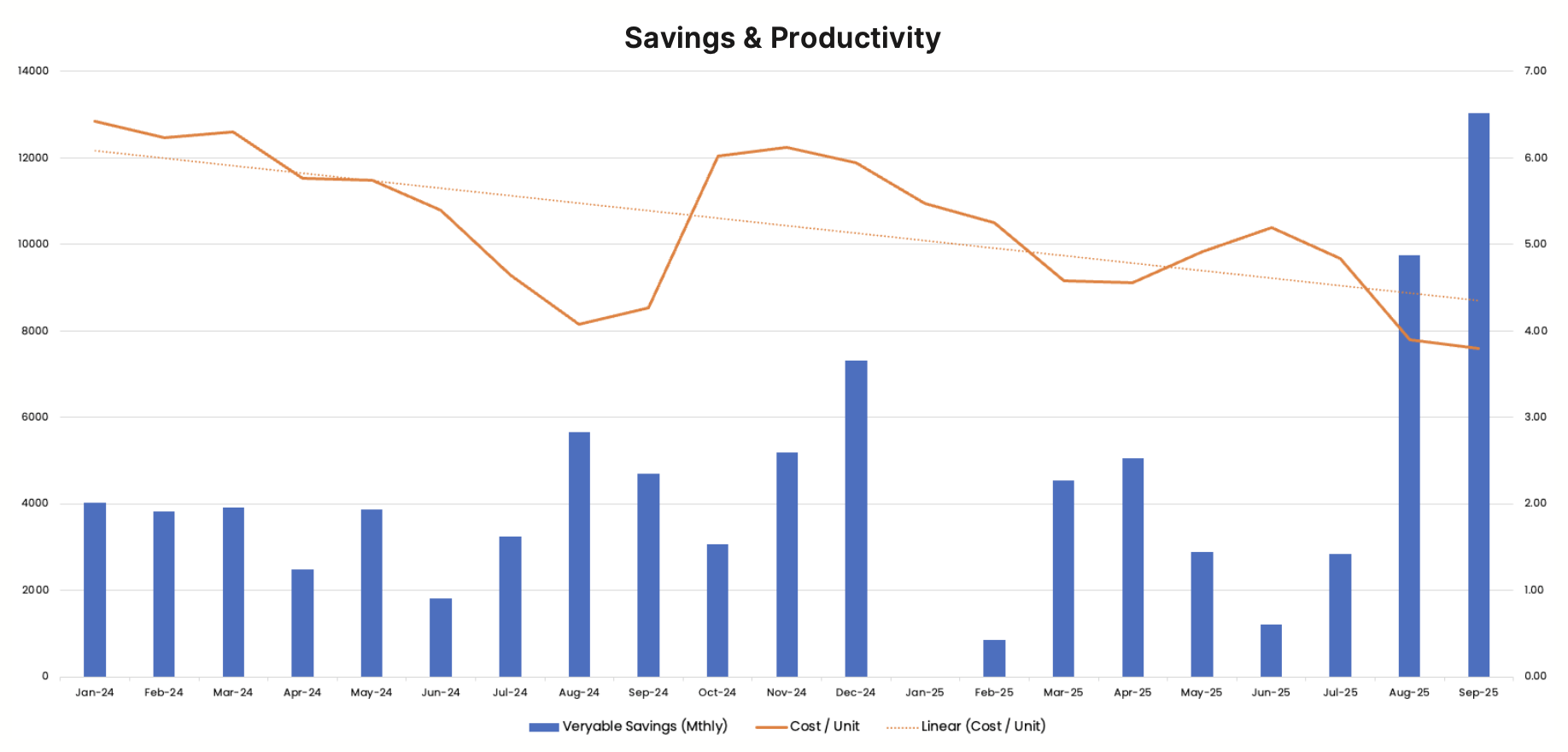Regional 3PL
A leading 3PL transformed its operations with Veryable’s on-demand labor model and Workforce Management platform, boosting efficiency 44% YTD and reducing cost per unit by 40.9%

3PL Boosts Efficiency 44%, Reduces Cost Per Unit 40% With On-Demand Labor and WFM
Background & Challenge
This third-generation, family-owned 3PL has been serving the Southeast since the 1950’s. With nearly three million square feet of warehouse space, the company supports sectors including manufacturing, chemicals, pulp & paper, and consumer packaged goods.
Like many 3PLs, the company struggled with unpredictable labor needs driven by volatile swings in customer demand. One product line in particular created major challenges, with drastic volume swings and ongoing lift driver shortages (Cherry Picker and Forklift) making it difficult to run facilities at full capacity. Traditional fixes such as temp agencies and direct hires provided workers who lacked the necessary experience, skills, and reliability. This left the company at risk of missing deliveries and putting strain on its core team.
Strategy and Adoption
The VP of Operations, already familiar with Veryable from a previous role, introduced the platform in two locations under two managers. From the beginning, the difference was clear: operators from the marketplace arrived with stronger warehouse backgrounds, more reliability, and advanced lift-driving skills compared to temp labor or direct hires.
This gave managers the ability to scale labor with confidence rather than settling for low-skill, unpredictable staffing. When one of the managers left, however, the remaining manager prioritized cost over reliability, and the marketplace went largely unused for nearly a year. This pause set the stage for a reset when Veryable’s Workforce Management (WFM) platform was introduced.
Expansion
Within months of adopting WFM, the company realized how consolidating FTEs and temp labor into a model centered on on-demand operators simplified scheduling, improved consistency, and cut unnecessary overhead. What began as a small pilot quickly expanded once leadership saw the operational and financial benefits.
WFM also revealed major gaps in productivity tracking. Managers’ reported UPH figures often differed from reality, limiting data-driven planning. To fix this, WFM added a comprehensive analytics dashboard showing daily and average UPH, inbound and outbound production, and overall efficiency trends. Automated reports now go to leadership daily, powered by integrations, eliminating manual data entry and giving managers real-time visibility.
Following early success, the company expanded use of WFM and the marketplace to a second site to handle demand fluctuations and fill lift driver gaps. Today, they rely on Veryable across two facilities and three work areas, with both tools playing a central role in their workforce strategy.
With WFM, we get daily reports that show us exactly what’s happening. That kind of visibility has completely transformed how we plan our operations, and it’s the main reason we’ve been able to push our efficiency so much higher.”
Director of Operations
The Outcome
By combining on-demand labor with WFM, the company has transformed a reactive labor model into a cohesive, data-driven operation. Marketplace operators keep facilities running at full capacity during demand spikes, while WFM gives leadership real-time visibility to plan, measure, and adjust proactively.
From January 2024 through September 2025, the results have been substantial. The on-demand marketplace has delivered $49,000 in savings, while WFM contributed an additional $53,500 in 2025 alone. Efficiency has climbed 44% year-to-date in 2025, and cost per unit has dropped 40.9%, proving that smarter workforce management directly improves productivity and profitability. Additionally, with accurate, automated reporting now in place, leadership is able to make proactive, data-driven decisions. The result is a leaner, more resilient operation that delivers consistent, cost-effective service at scale.
Measuring The Operational Impact

This chart compares monthly order volume with units-per-
hour (UPH). From January to September, UPH climbed even as volume increased, showing measurable gains.
Efficiency outpaces demand: UPH growth outstripped volume
increases, demonstrating a more effective strategy.
Resilience during fluctuations: When order volumes dipped mid-year, UPH remained strong, highlighting consistency.
44% year-to-date improvement: Output per labor hour has
surged since January, lowering cost per unit while boosting overall performance.

Ready to unlock the same results?
Contact us today to learn how Veryable's On-Demand Labor model and Workforce Management (WFM) platform can transform your operations.
See Veryable for Yourself
Create a free business profile today to explore our platform.

